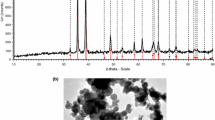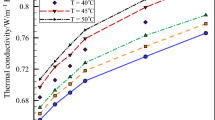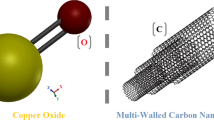Abstract
In the present study, the results of several experiments have been used to obtain the thermal conductivity of multi walls carbon nanotubes-water nanofluid. For this purpose, COOH-functionalized MWCNTs nanoparticles have divided into different solid volume fractions in order to disperse in water as the base fluid by different dispersion methods. The thermal conductivity measurement applied in different solid concentrations, up to 1 %, and at the temperatures ranging from 25 to 55 °C. In this paper, based on the experimental data, a new correlation for predicting the thermal conductivity of COOH-functionalized MWCNTs/water nanofluid proposed. After that, for simulating the thermal conductivity of this nanofluid, the artificial neural network is used. For this purpose, multilayer percepetron neural network is used. The network input variables are temperature and solid volume fraction, and the network output variable is thermal conductivity. The results extracted from the artificial neural network show good agreement with the experimental data. The mean square error value is 4.04E−06 that shows excellent performance of artificial neural network to predict thermal conductivity of COOH-functionalized MWCNTs/water nanofluid.








Similar content being viewed by others
Abbreviations
- k :
-
Thermal conductivity, Wm−1 K−1
- Re:
-
Reynolds number
- T :
-
Temperature, K
- MSE:
-
Mean square error
- RMSE:
-
Root mean square error
- MAE:
-
Maximum absolute error
- MLP:
-
Feedforward multilayer percepetron
- φ :
-
Solid volume fraction
- b:
-
Base fluid
- nf:
-
Nanofluid
- Pred:
-
Predicted value
- Exp:
-
Experimental value
References
Saidur R, Leong KY. A review on applications and challenges of nanofluids. Renew Sustain Energy Rev. 2011;15:1646–68.
Mahian O, Kianifar A, Kalogirou SA, Pop I, Wongwises S. A review of the applications of nanofluids in solar energy. Int J Heat Mass Transf. 2013;57:582–94.
Wang W. A comprehensive model for the enhanced thermal conductivity of nanofluids. J Adv Res Phys. 2012;3:5.
Ghadimi A, Saidur R, Metselaar HSC. A review of nanofluid stability properties and characterization in stationary conditions. Int J Heat Mass Transf. 2011;54:4051–68.
Gupta M, Arora N, Kumar R, Kumar S, Dilbaghi N. A comprehensive review of experimental investigations of forced convective heat transfer characteristics for various nanofluids. Int J Mech Mater Eng. 2014;9:1–21.
Vajjha RS, Das DK. A review and analysis on influence of temperature and concentration of nanofluids on thermophysical properties, heat transfer and pumping power. Int J Heat Mass Transf. 2012;55:4063–78.
Hemmat Esfe M, Saedodin S, Mahian O, Wongwises S. Thermophysical properties, heat transfer and pressure drop of COOH-functionalized multi walled carbon nanotubes/water nanofluids. Int Commun Heat Mass Transf. 2014;58:176–83.
Hemmat Esfe M, Saedodin S, Mahian O, Wongwises S. Heat transfer characteristics and pressure drop of COOH-functionalized DWCNTs/water nanofluid in turbulent flow at low concentrations. Int J Heat Mass Transf. 2014;73:186–94.
Phuoc TX, Massoudi M, Chen RH. Viscosity and thermal conductivity of nanofluids containing multi-walled carbon nanotubes stabilized by chitosan. Int J Therm Sci. 2011;50:12–8.
Nasiri A, Shariaty-Niasar M, Rashidi AM, Khodafarin R. Effect of CNT structures on thermal conductivity and stability of nanofluid. Int J Heat Mass Transf. 2012;55:1529–35.
Hemmat Esfe M, Saedodin S, Mahian O, Wongwises S. Thermal conductivity of Al2O3/water nanofluids Measurement, correlation, sensitivity analysis, and comparisons with literature reports. J Therm Anal Calorim. 2014;117:675–81. doi:10.1007/s10973-014-3771-x.
Barbe´s B, Pa´ramo R, Blanco E, Pastoriza-Gallego MJ, Pin˜eiro MM, Legido JL, Casanova C. Thermal conductivity and specific heat capacity measurements of Al2O3nanofluids. J Thermal Anal Calorim. 2013;11:1615–25.
Papari MM, Yousefi F, Moghadasi J, Karimi H, Campo A. Modeling thermal conductivity augmentation of nanofluids using diffusion neural networks. Int J Therm Sci. 2011;50:44–52.
Hemmat Esfe M, Saedodin S, Mahian M, Wongwises S. Efficiency of ferromagnetic nanoparticles suspended in ethylene glycol for applications in energy devices: effects of particle size, temperature, and concentration. Int Commun Heat Mass Transf. 2014;58:138–46.
Sundar LS, Sharma KV, Naik MT, Singh MK. Empirical and theoretical correlations on viscosity of nanofluids: a review. Renew Sustain Energy Rev. 2013;25:670–86.
Hemmat Esfe M, Saedodin S. An experimental investigation and new correlation of viscosity of ZnO—EG nanofluid at various temperatures and different solid volume fractions. Exp Therm Fluid Sci. 2014;55:1–5.
Khaleduzzaman SS, Mahbubul IM, Shahrul IM, Saidur R. Effect of particle concentration, temperature and surfactant on surface tension of nanofluids. Int Commun Heat Mass Transf. 2013;49:110–4.
Hemmat Esfe M, Saedodin S, Asadi M, Karimipour A. Thermal conductivity and viscosity of Mg(OH)2-ethylene glycol nanofluids: finding a critical temperature. J Therm Anal Calorim. doi:10.1007/s10973-015-4417-3.
Kurt H, Kayfeci M. Prediction of thermal conductivity of ethylene glycol–water solutions by using artificial neural networks. Appl Energy. 2009;86:2244–8.
Hojjat M, Etemad SG, Bagheri R, Thibault J. Thermal conductivity of non-Newtonian nanofluids: experimental data and modeling using neural network. Int J Heat Mass Transf. 2011;54:1017–23.
Hemmat Esfe M, Saedodin S, Bahiraei M, Toghraie D, Mahian O, Wongwises W. Thermal conductivity modeling of MgO/EG nanofluids using experimental data and artificial neural network. J Therm Anal Calorim. 2014;118:287–94.
Hemmat Esfe M, Saedodin S, Mahian O, Wongwises S. Thermophysical properties, heat transfer and pressure drop of COOH-functionalized multi walled carbon nanotubes/water nanofluid. Int Commun Heat Mass Transfer. 2014;58:176–83.
Longo GA, Zilio C, Ceseracciu E, Reggiani M. Application of artificial neural network (ANN) for the prediction of thermal conductivity of oxide–water nanofluids. Nano Energy. 2012;1:290–6.
Di Nicola G, Ciarrocchi E, Coccia G. Correlations of thermal conductivity for liquid refrigerants at atmospheric pressure or near saturation. Int J Refrig. 2014;45:168–76.
Hemmat Esfe M, Saedodin S, Mahmoodi M. Experimental studies on the convective heat transfer performance and thermophysical properties of MgO–water nanofluid under turbulent flow. Exp Therm Fluid Sci. 2014;52:68–78.
Hemmat Esfe M, Saedodin S. Turbulent forced convection heat transfer and thermophysical properties of Mgo–water nanofluid with consideration of different nanoparticles diameter, an empirical study. J Therm Anal Calorim. doi:10.1007/s10973-014-4197-1.
Hemmat Esfe M, Saedodin S, Asadi A. An empirical investigation on the dynamic viscosity of Mg(OH)2- ethylene glycol in different solid concentrations and proposing new correlation based on experimental data. Int J Nat Eng Sci. 2014;8(3):29–34.
Hemmat Esfe M, Zare Ghadi A, Mirtalebi Esforjani SS, Akbari M. Combined convection in a lid-driven cavity with an inside obstacle subjected to Al2O3-water nanofuid: effect of solid volume fraction and nanofuid variable properties. Acta Phys Pol A. 2013;12(4):665–72. doi:10.12693/APhysPolA.124.665.
Hemmat Esfe M, Niazi S, Sadegh Mirtalebi Esforjani S, Akbari M. Mixed convection flow and heat transfer in a ventilated inclined cavity containing hot obstacles subjected to a nanofluid. Heat Transf Res. 2014;45(4):309–38.
Author information
Authors and Affiliations
Corresponding author
Rights and permissions
About this article
Cite this article
Hemmat Esfe, M., Naderi, A., Akbari, M. et al. Evaluation of thermal conductivity of COOH-functionalized MWCNTs/water via temperature and solid volume fraction by using experimental data and ANN methods. J Therm Anal Calorim 121, 1273–1278 (2015). https://doi.org/10.1007/s10973-015-4565-5
Received:
Accepted:
Published:
Issue Date:
DOI: https://doi.org/10.1007/s10973-015-4565-5




